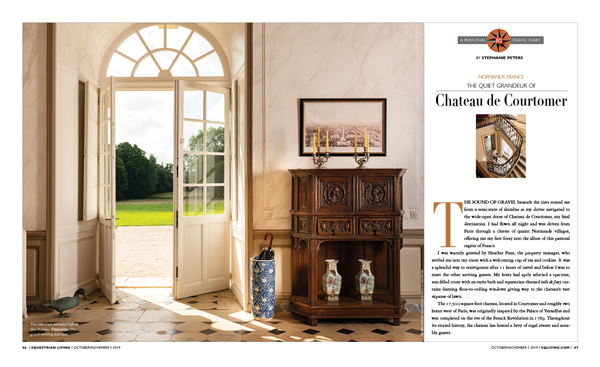
Read the full feature and see more photos in Equestrian Living magazine.
The sound of gravel beneath the tires roused me from a semi-state of slumber as my driver navigated to the wide-open doors of Chateau de Courtomer, my final destination. I had flown all night and was driven from Paris through a cluster of quaint Normandy villages, offering me my first foray into the allure of this pastoral region of France.
I was warmly greeted by Heather Pane, the property manager, who settled me into my room with a welcoming cup of tea and cookies. It was a splendid way to reinvigorate after 11 hours of travel and before I was to meet the other arriving guests. My hosts had aptly selected a spacious, sun-filled room with en-suite bath and equestrian-themed toile de Jouy curtains framing floor-to-ceiling windows giving way to the chateau’s vast expanse of lawn.
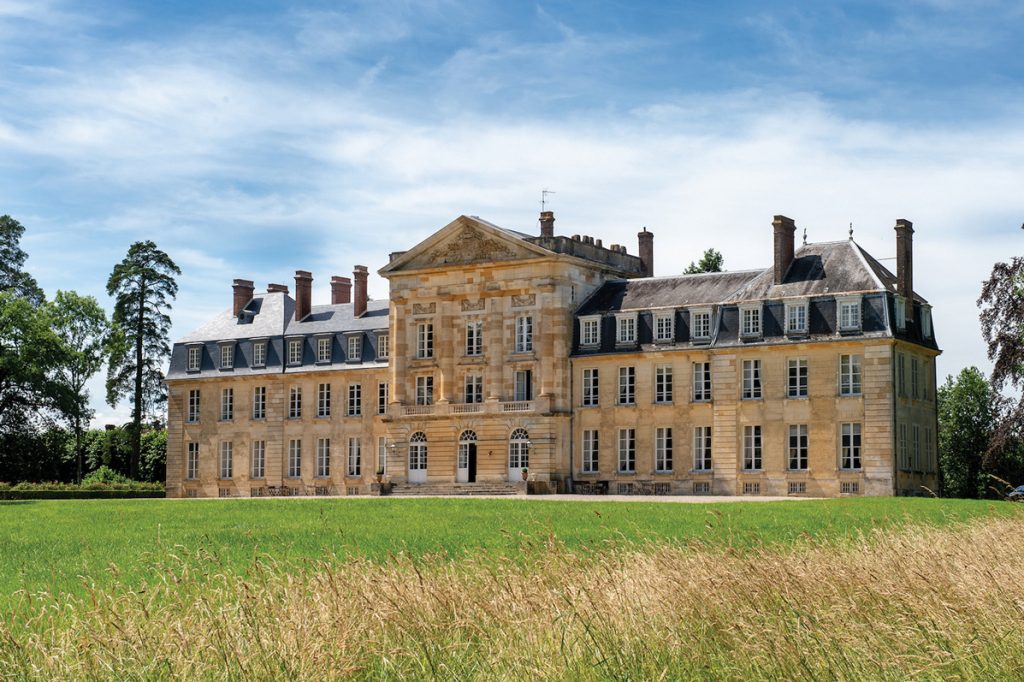
The 17,500-square-foot chateau, located in Courtomer and roughly two hours west of Paris, was originally inspired by the Palace of Versailles and was completed on the eve of the French Revolution in 1789. Throughout its storied history, the chateau has hosted a bevy of regal events and notable guests.
Today, this glorious chateau and 350-acre property is owned by the Bonner family and continues to welcome guests to enjoy its splendor and blissfully peaceful environment. One has no choice but to abandon any stress at the door.
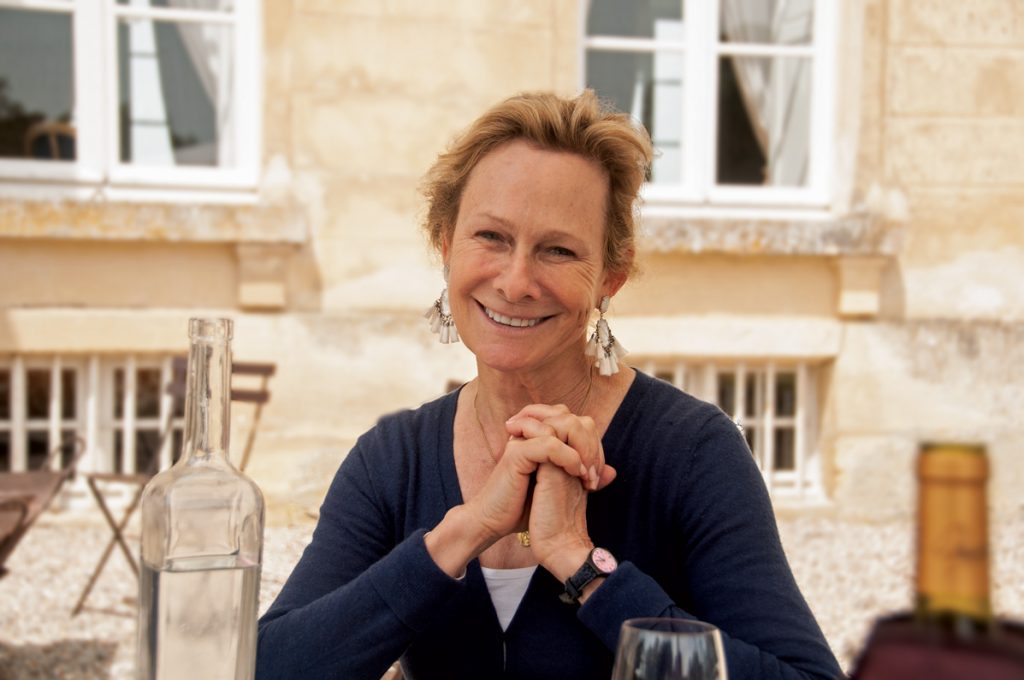
I was fortunate enough to share an alfresco lunch and conversation with Elisabeth Bonner while we grazed on a light repast of salad, local cheeses, and a crisp white wine. I had read a sampling of her colorful comments describing the restoration after their purchase in 2005: “When we stumbled across it, the chateau was like a beautiful woman in shabby clothing. Ragged, but luminous.”
Elisabeth has been the driving force and visionary behind the extensive and on-going renovation, which has rendered a home that is simultaneously elegant and inviting. Furnishings, carefully selected fabrics—particularly 18th-century reproductions—a soothing paint palette of glazed lemony yellows, greens, and grays, beckon guests to sit fireside with a good book and locally aged Calvados. Her effort and attention to detail, which entailed countless visits to Paris fabric houses and days at Drouot, the famed auction house of Paris, has infused this impressive chateau with an environment conducive to creating unforgettable experiences. She admitted, “There is something exhilarating about restoring a great house to its former splendor.”
I’m an easy target for secreted legends and tales of thwarted loves, so I was especially interested to hear about unique discoveries during the deconstruction. While investigating a roof leak, a packet of love letters dating back to the 14th century was found tucked into the attic beams. Also uncovered was an 18th-century marriage contract tied with ribbon, and stacks of black and white photographs of racehorses owned by the Compte de Pelet, a former owner of the estate.
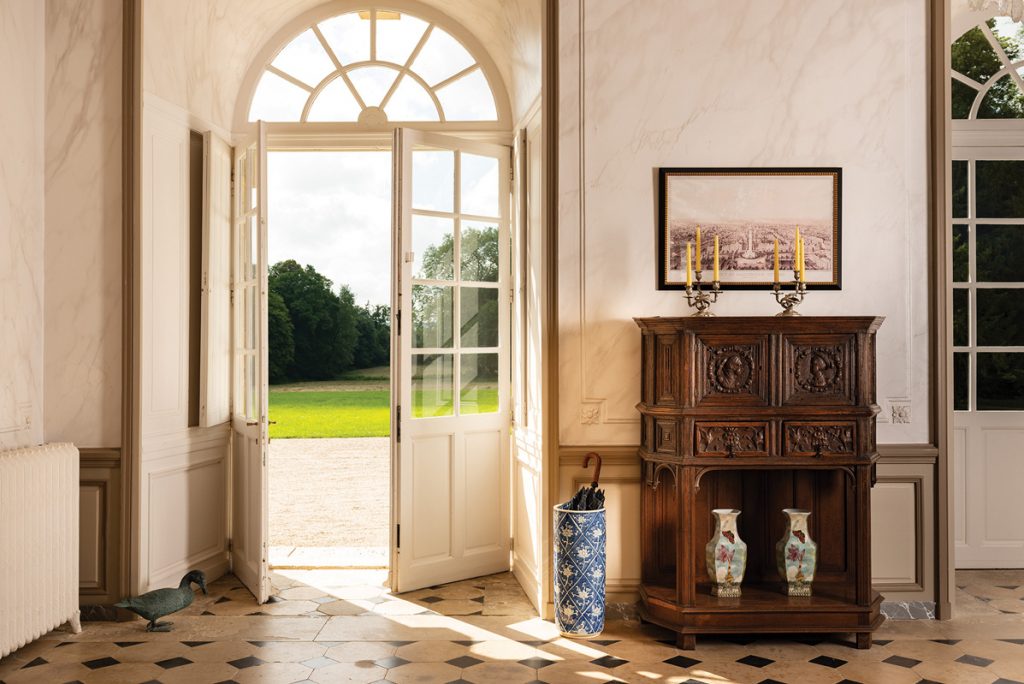
Horses and Chateau de Courtomer
Horses were an integral mainstay of the chateau. “The cour d’entrée, the grassy courtyard between the two moats on the property, is surrounded by a circular driveway. Here at the chateau, it has always been called a manège, which is a circular outdoor riding space,” explained Elisabeth. “At Courtomer, it may have been used to exercise horses or to gather mounted riders for drinks before heading out to the hunt.”
Elisabeth shared a bit about the local hunts, which are called equipe. “They don’t fox hunt here, they stag hunt, and it’s a great ritual,” she said. “It’s very different than American or English fox hunting. I was always taught that you never pass the master. Ha! Here everybody is on their own! It’s a very funny thing and seems disorganized. People are just all over the place finding their way. I was always lost,” she laughed.

She explained that the hunt is purposeful and respectful, and that it serves to control the deer populations. They hunt with Poitevin, a breed of long-legged, tricolor scent hounds, developed in France and capable of proficiently hunting large animals. “They keep the hounds on the stag; they never hunt the female,” Elisabeth added.
Normandy is an idyllic region for horse breeding as well as horse sport across several disciplines. The Haras du Pin, the aristocratic and oldest of the 23 French national studs, was built by Louis the XIV in 1714 because of the mineral-rich “French bluegrass” as it’s called. There is a famous saying in Normandy that emphasizes the breeding-friendly conditions: “They say a man can hear the grass growing.” At one time the Haras du Pin had seven different horse breeds, but now they are primarily focused on Percherons and racehorses.
Visual nods to the esteem for horses at the chateau are both subtle and dramatic. In the library, scattered between leather-bound tomes, are annals of horse racing in France, books about equine veterinary matters, and framed black-and-white photos of horses, prominently displayed on shelves. Less understated is an imposing portrait of the chateau’s builder, Marquis de Saint Simon de Courtomer, mounted on his white warhorse, hung at the top of the majestic staircase.

Out and about in Normandy
The location of the chateau is perfect for exploring the lush countryside and surrounding villages of Normandy, offering opportunities to tour and sample the gastronomic bounty of this region.
Embracing my inner gourmand, I relished the visit to Le Village Fromage in Livarot, where we watched various stages of cheese making from behind glass walls. Although no longer able to step directly onto the floor of the factory due to European rules, I was delighted to taste their house Pont L’Évêque. On subsequent occasions during my stay, I was introduced to Livarot, Camembert, Neufchâtel, and other delicious cheeses of the area. The exceptional quality of local cheeses, butter, and fresh cream are attributed to the region’s much-revered Norman cows.
Should you find yourself on the cider route and a touch thirsty, a visit to Pierre-Huet in Cambremer to tour the cider-making process and sample barrel-aged Calvados—a strong apple brandy—will be a memorable stop. Bottles of the finest aged Calvados were buried throughout the region during World War II, and local lore asserts that some of those bottles are yet to be found. While in the village of Cambremer, a meal at the mother-and-daughter owned Au P’tit Normand, a charming café with flawlessly prepared bistro fare, will also be an experience to savor.
The timing of my trip coincided with the 75th anniversary of D-Day. It’s hard to ignore the impact of World War II and the significant loss of life that occurred throughout this quiet countryside. The Memorial de Montormel in the Orne region of Normandy nobly honors the site where Germany surrendered to allied forces in 1944. The memorial’s photos of local villages after the war illustrate the resilient character of the region’s residents. Rebuilt towns in traditional Norman-style architecture once again display their unique charm and ingenuity.
Relax in splendor with friends and family
For those wishing not to venture far afield, the chateau and its extensive grounds offer much to explore. There is the quaint village of Courtomer, just a short walk or bike ride away, and 350 acres of private parkland to meander through.
A hot-air balloon ride can be arranged to conveniently launch from the chateau’s front lawn. The experience of quietly drifting across the lush green Normandy landscape of farms, century-old chapels, and myriad animals grazing below is an adventure I won’t soon forget. Returning at dusk and warming up by a crackling fire in the library was the ultimate homecoming.

The 25-bedroom rental chateau is idyllic for destination weddings, family gatherings, or off-site business retreats. The outstanding staff can offer the highest level of assistance and service in creating the perfect event—whether recommending private chefs or caterers, or directing you to local markets and giving you access to their fully equipped chef’s kitchen. The chateau can comfortably host intimate dinners for 15 or receptions for 50. There are a variety of dining spaces on the property that range from formal dining rooms to casual outdoor spaces or the relaxed orangerie.
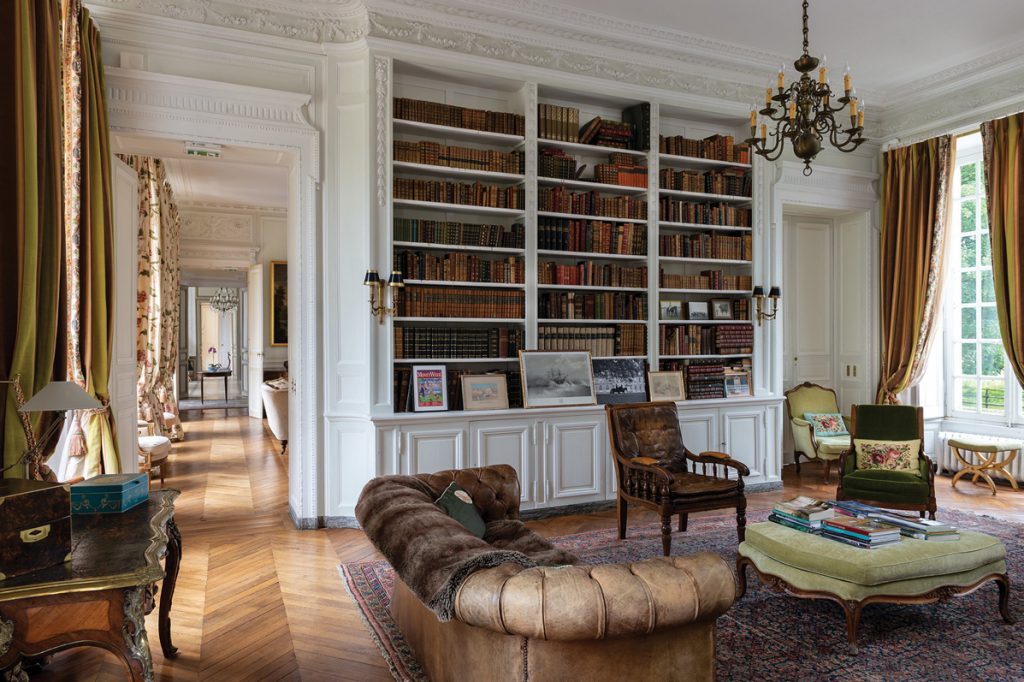
Chef Franke Ete served delectable meals throughout my brief stay. Breakfasts in the airy dining room had generous offerings of yogurts, fresh fruits, cereals, and baked goods, and eggs of any style could instantly be prepared to order. Dinners ran the gamut from an alfresco shellfish extravaganza with mounded plates of oysters, oversized prawns, urchins, and crab, to a relaxed barbeque topped off with Franke’s famous cheesecake and Heather’s edible chocolate bowls, and to an impeccable formal dinner.
Our final gathering at the chateau was in the formal dining room where Chef Franke presented a lavish seven-course dinner replete with sorbet palate cleansers. It was bittersweet knowing, as people sipped wine and chatted in the flickering candlelight, that the fascinating group gathered at the table would soon be going their separate ways.
That’s the thing about Chateau de Courtomer—guests may arrive as strangers or loose acquaintances, but after shared experiences and heartfelt stories told, most will depart as friends.
The Horses of Normandy
I embarked on an afternoon of visits to area breeding farms with Dominique Eudier, our knowledgeable Normandy tour guide and avid equestrian. Not only was she fluent in English, she was also well versed in the equestrian culture of Normandy.
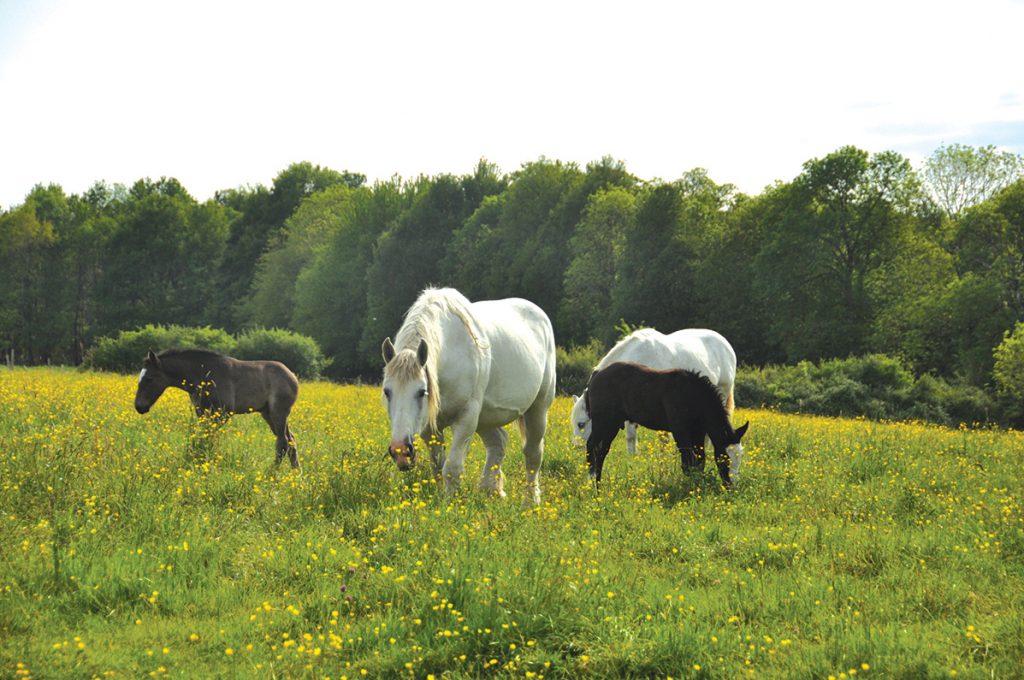
Sport Horses | A visit with Bernard Le Courtois
We first visited Brullemail. “I am like Maurice Chevalier with my French accent,” laughs owner Bernard Le Courtois. “I am a horse breeder.” Forty years ago he was a journalist for a French magazine, but now he is a renowned sport-horse breeder. Following 10 years in the publishing industry, he had an opportunity to syndicate two stallions: Laudanum and the famous Almé. “When I bought these two stallions I decided to realize my childhood dream to become a breeder,” smiles Le Courtois.
In his youth, Bernard was an accomplished rider and able to jump national grand prix. He stopped his university studies for one year to see if he could compete professionally at this level. “I worked with two professional riders, but eventually I understood I wasn’t very talented or marketable. I discovered there are only two ways to become a professional rider: be exceptionally talented and courageous, or marry a rich woman or come from a very rich family who can pay for horses and coaching,” he laughs. “I was not rich or talented enough, so at 20 years old I decided I had to find another way.
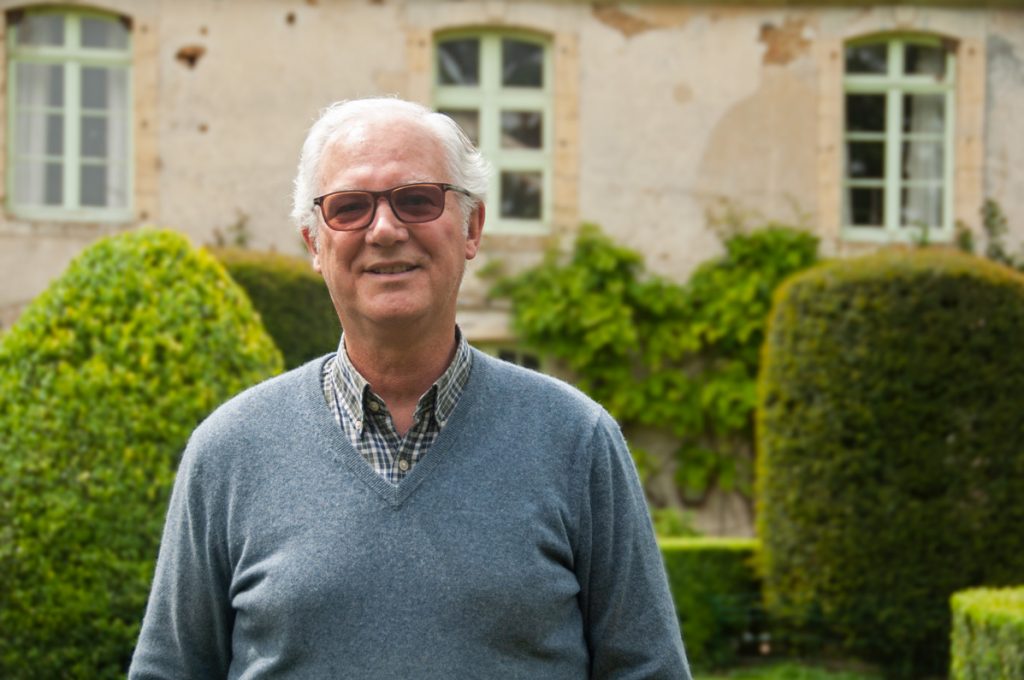
“I met a very famous French breeder, Madame Colette Lefranc-Ducornet, who was the breeder of Galoubet A, one of the best sons of Almé and syndicated for $2 million in America 40 years ago,” says Le Courtois. “She decided to stop breeding when she felt she was too old, and she gave me all of her brood mares.
“When I arrived here the farm was in ruins,” admits Le Courtois. “The house had no windows, the roof was broken, and I rented the farm for the first 20 years. But I worked with everything and the first horses started to arrive in 1986. The first stallion was I Love You, who was a selle français, a French sport horse, and jumped for the American team with Norman Dello Joio. He won the world cup final in Vienna in 1983 and was the horse of the year in America. I Love You moved back to France after finishing his jumping career and I syndicated him for many years. I imported another selle français who jumped in America. His name was Noren and he was ridden by Katie Monahan, a famous rider on the American team. Noren was also the horse of the year,” adds Le Courtois.
“I started here in 1986 with two stallions and the brood mares and that was the beginning,” says Le Courtois. “All of the breeding is done here. The farm started as 120 acres and has expanded to 250 acres. I chose this area because of the quality of the bluegrass. I am from Brittany, but this part of Normandy is the best ground to breed horses,” he admits.
He has improved his selection generation after generation. “I began with 12 or 15 different brood mares from different lineage and now I am working with 5 different dam lines,” explains Le Courtois. All the horses born on his stud farm have a first name plus an affix, “Mail.” His most famous stallion, Jaguar Mail, is considered the best stallion in France, and the second best in the world, to produce eventers. Currently, Le Courtois’ breeding focus is 90 percent selle français show jumpers or eventers and 10 percent Thoroughbred racing.
Trotters
From there we traveled to Haras De Sassy, a sophisticated breeding facility for trotters, which boasted a modern insemination center and a state-of-the-art balneotherapy rehabilitation facility. Dominique explained that French trotters have to be strong enough to carry a jockey or a sulky. The U.S. harness racers are thinner and faster.
“Years ago, Haras du Pin had a U.S. trotter come to the stud farm to mate with local trotter mares to give their French trotters the speed that was lacking,” explains Dominique. “That trotter was called Workaholic and he had a long list of fiancés!”
Percherons
Our final stop was at the Percheron stud farm, Elevage des Forges, owned by Martine Michaux. Originally starting with a single horse, the farm has built that number to 200. The farm’s Percherons, known for their strength and physical characteristics, are currently sold around the world.
Again, the French looked to the U.S. to regain the Percheron’s original physical traits. “Once tractors appeared and took over the Percheron’s jobs, they got bigger and bigger,” says Dominique. “We had modified the physical characteristics of our Percherons by making them too fat and they lost their elegance and physical capacity. In the 19th century, our Percherons were sent to America to work and they kept the true characteristics of our horses. The mission of the Haras du Pin was to improve the breed of our horses. They mated Silver Shadows Sheik, a U.S. Percheron stallion, with a French Percheron mare and the offspring became progressively more like him,” smiles Dominique. “He greatly improved our Percheron breed.”
